Indigenous Health Issue: Impact of Low Fruit and Vegetable Intake
VerifiedAdded on 2022/11/24
|11
|3087
|1
Report
AI Summary
This report investigates the critical health issues affecting Aboriginal and Torres Strait Islander populations in Australia, primarily focusing on the detrimental effects of low fruit and vegetable intake. The study highlights the link between poor nutrition and chronic diseases such as malnutrition, type 2 diabetes, cardiovascular disease, and high blood pressure. It explores the various social determinants of health, including socioeconomic disadvantages, lack of access to healthy foods, and limited health literacy, which contribute to these health disparities. The report examines the 'Closing the Gap' strategy implemented by the Australian government and other health programs to improve nutrition and reduce health inequalities. The report underscores the importance of community-based nutrition programs, education, and initiatives aimed at increasing awareness and access to nutritious foods to address the alarming rate of nutrition-related health issues and reduce mortality rates within the Indigenous population.
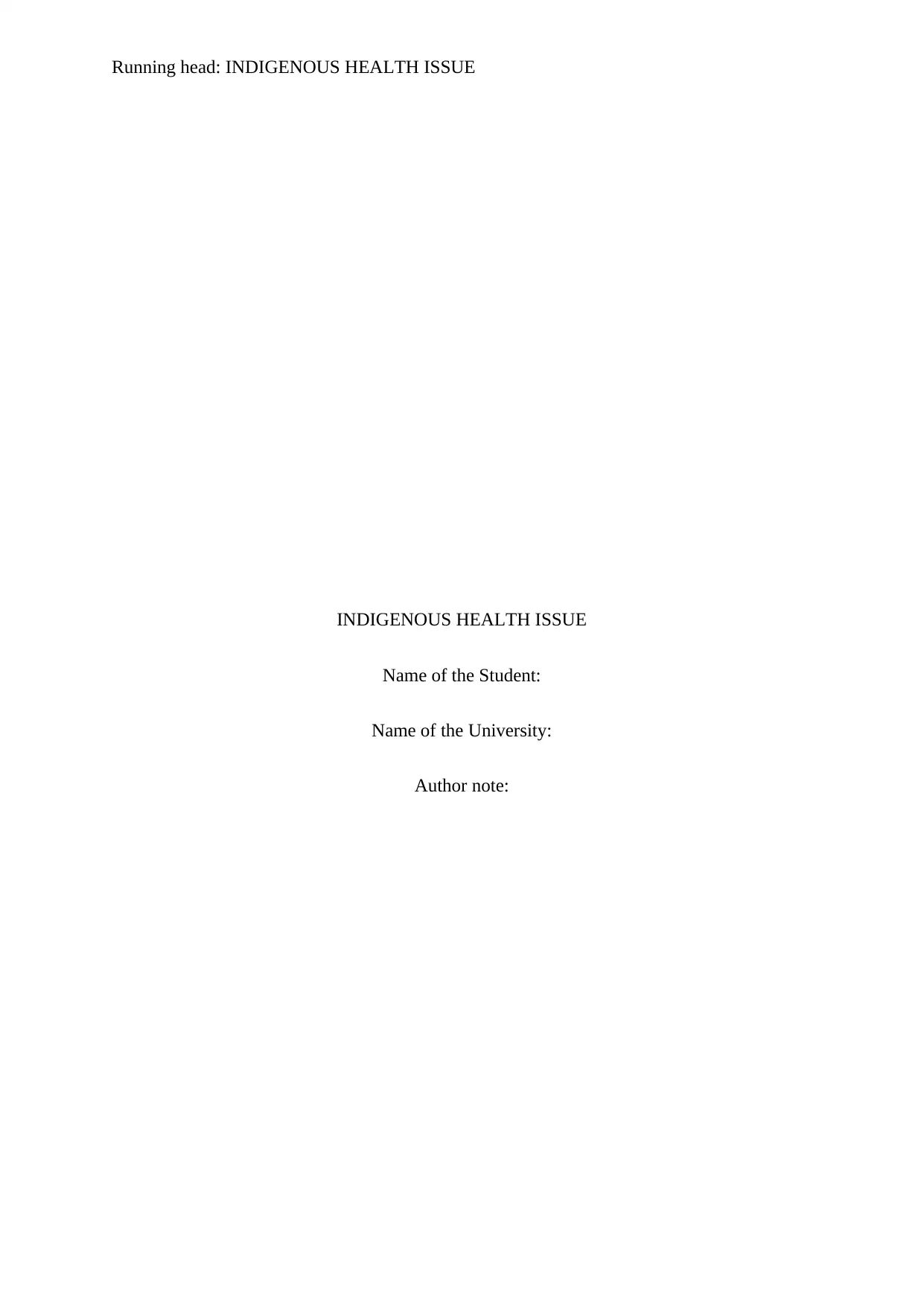
Running head: INDIGENOUS HEALTH ISSUE
INDIGENOUS HEALTH ISSUE
Name of the Student:
Name of the University:
Author note:
INDIGENOUS HEALTH ISSUE
Name of the Student:
Name of the University:
Author note:
Paraphrase This Document
Need a fresh take? Get an instant paraphrase of this document with our AI Paraphraser

1INDIGENOUS HEALTH ISSUE
Low intake of fruit and vegetables result in a nutritional imbalance among the
indigenous population that is responsible for severe health issues like malnutrition, type 2
diabetes, cardiovascular disease and high blood pressure. Hence, the study aims to identify
the health issue and the factor that is responsible for accelerating this issue among the
Aboriginal and Torres Strait Islander population. The aboriginal and Torres Strait Islander are
the primary residents of Australia, who grieve from deprived well-being condition as related
to the other Australians because they are largely open to diverse determinants of health that
result in poor health. The Aboriginal and Torres Strait Islander people mostly belong to the
poor socio-economic background with deprived developmental knowledge, which is further
accountable for deteriorating health illness of the population (Australian Institute of
Aboriginal and Torres Strait Islander Studies, 2019). This study will focus on the deprived
well-being condition of the Aboriginal and Torres Strait Islander people because they are
unable to eat proper food that is rich in nutrients and minerals. The deprived diet is directly
related to the onset of diet-associated chronic issues that result in high mortality rate among
the Aboriginal and Torres Strait Islander people as linked to the other Australian population
(Lukaszyk et al. 2018). This study will highlight the factors or social determinants of health
that is majorly accountable for the deprived health situation of the people associated with the
contemporary healthcare strategy that will aim to reduce the health issues faced by large
population of Aboriginal and Torres Strait Islander people. The study will conclude by
exhibiting the crucial and effective program that will be completely acceptable by the
population and also as sit in reducing the alarming rate of nutrition-related health issue (Blake
et al. 2018).
A large amount of Aboriginal and Torres Strait Islander individuals suffer from
different types of health issues that arise because of different social determinants of health.
Internationally, huge number of indigenous population suffers from bad health condition and
Low intake of fruit and vegetables result in a nutritional imbalance among the
indigenous population that is responsible for severe health issues like malnutrition, type 2
diabetes, cardiovascular disease and high blood pressure. Hence, the study aims to identify
the health issue and the factor that is responsible for accelerating this issue among the
Aboriginal and Torres Strait Islander population. The aboriginal and Torres Strait Islander are
the primary residents of Australia, who grieve from deprived well-being condition as related
to the other Australians because they are largely open to diverse determinants of health that
result in poor health. The Aboriginal and Torres Strait Islander people mostly belong to the
poor socio-economic background with deprived developmental knowledge, which is further
accountable for deteriorating health illness of the population (Australian Institute of
Aboriginal and Torres Strait Islander Studies, 2019). This study will focus on the deprived
well-being condition of the Aboriginal and Torres Strait Islander people because they are
unable to eat proper food that is rich in nutrients and minerals. The deprived diet is directly
related to the onset of diet-associated chronic issues that result in high mortality rate among
the Aboriginal and Torres Strait Islander people as linked to the other Australian population
(Lukaszyk et al. 2018). This study will highlight the factors or social determinants of health
that is majorly accountable for the deprived health situation of the people associated with the
contemporary healthcare strategy that will aim to reduce the health issues faced by large
population of Aboriginal and Torres Strait Islander people. The study will conclude by
exhibiting the crucial and effective program that will be completely acceptable by the
population and also as sit in reducing the alarming rate of nutrition-related health issue (Blake
et al. 2018).
A large amount of Aboriginal and Torres Strait Islander individuals suffer from
different types of health issues that arise because of different social determinants of health.
Internationally, huge number of indigenous population suffers from bad health condition and
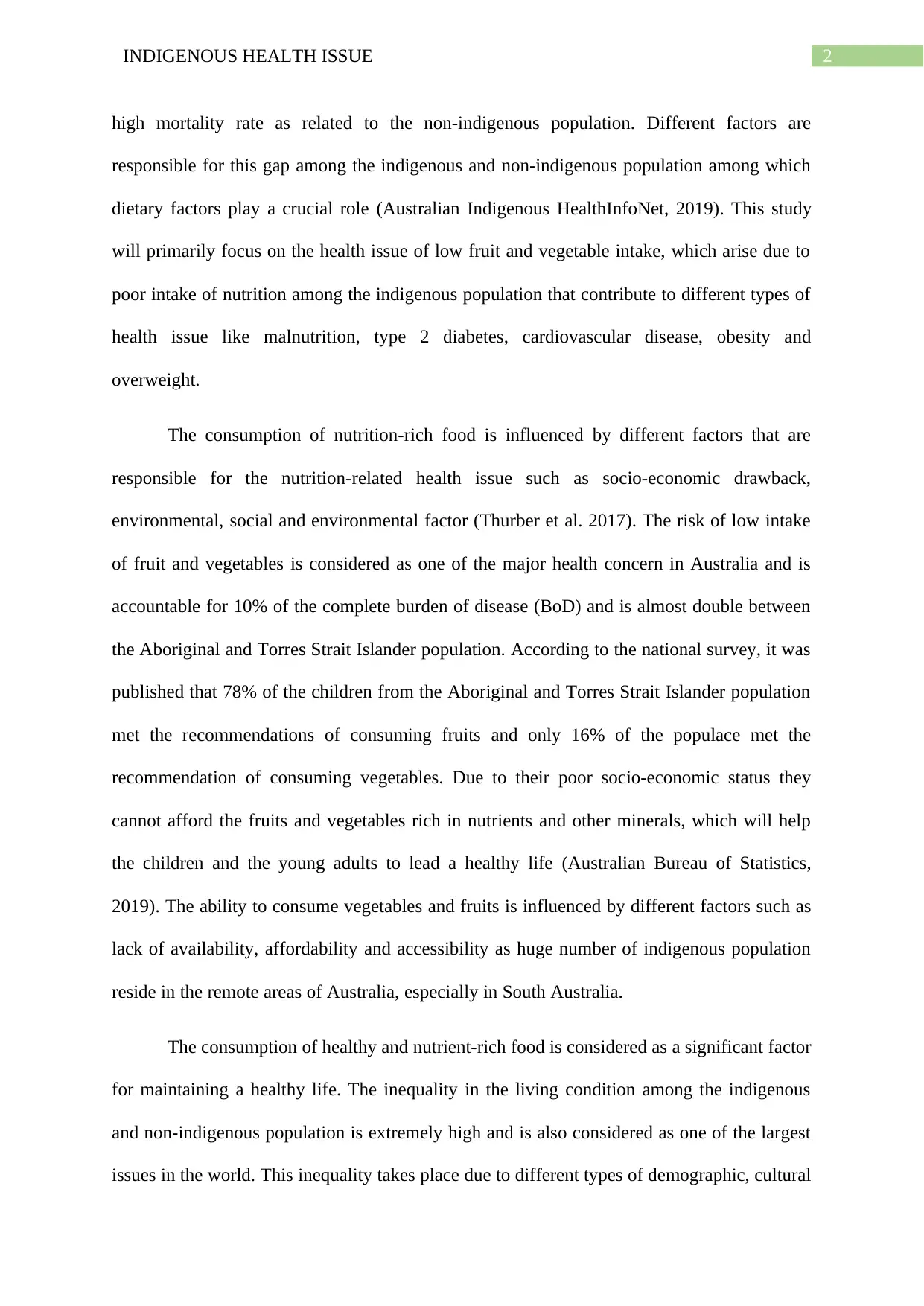
2INDIGENOUS HEALTH ISSUE
high mortality rate as related to the non-indigenous population. Different factors are
responsible for this gap among the indigenous and non-indigenous population among which
dietary factors play a crucial role (Australian Indigenous HealthInfoNet, 2019). This study
will primarily focus on the health issue of low fruit and vegetable intake, which arise due to
poor intake of nutrition among the indigenous population that contribute to different types of
health issue like malnutrition, type 2 diabetes, cardiovascular disease, obesity and
overweight.
The consumption of nutrition-rich food is influenced by different factors that are
responsible for the nutrition-related health issue such as socio-economic drawback,
environmental, social and environmental factor (Thurber et al. 2017). The risk of low intake
of fruit and vegetables is considered as one of the major health concern in Australia and is
accountable for 10% of the complete burden of disease (BoD) and is almost double between
the Aboriginal and Torres Strait Islander population. According to the national survey, it was
published that 78% of the children from the Aboriginal and Torres Strait Islander population
met the recommendations of consuming fruits and only 16% of the populace met the
recommendation of consuming vegetables. Due to their poor socio-economic status they
cannot afford the fruits and vegetables rich in nutrients and other minerals, which will help
the children and the young adults to lead a healthy life (Australian Bureau of Statistics,
2019). The ability to consume vegetables and fruits is influenced by different factors such as
lack of availability, affordability and accessibility as huge number of indigenous population
reside in the remote areas of Australia, especially in South Australia.
The consumption of healthy and nutrient-rich food is considered as a significant factor
for maintaining a healthy life. The inequality in the living condition among the indigenous
and non-indigenous population is extremely high and is also considered as one of the largest
issues in the world. This inequality takes place due to different types of demographic, cultural
high mortality rate as related to the non-indigenous population. Different factors are
responsible for this gap among the indigenous and non-indigenous population among which
dietary factors play a crucial role (Australian Indigenous HealthInfoNet, 2019). This study
will primarily focus on the health issue of low fruit and vegetable intake, which arise due to
poor intake of nutrition among the indigenous population that contribute to different types of
health issue like malnutrition, type 2 diabetes, cardiovascular disease, obesity and
overweight.
The consumption of nutrition-rich food is influenced by different factors that are
responsible for the nutrition-related health issue such as socio-economic drawback,
environmental, social and environmental factor (Thurber et al. 2017). The risk of low intake
of fruit and vegetables is considered as one of the major health concern in Australia and is
accountable for 10% of the complete burden of disease (BoD) and is almost double between
the Aboriginal and Torres Strait Islander population. According to the national survey, it was
published that 78% of the children from the Aboriginal and Torres Strait Islander population
met the recommendations of consuming fruits and only 16% of the populace met the
recommendation of consuming vegetables. Due to their poor socio-economic status they
cannot afford the fruits and vegetables rich in nutrients and other minerals, which will help
the children and the young adults to lead a healthy life (Australian Bureau of Statistics,
2019). The ability to consume vegetables and fruits is influenced by different factors such as
lack of availability, affordability and accessibility as huge number of indigenous population
reside in the remote areas of Australia, especially in South Australia.
The consumption of healthy and nutrient-rich food is considered as a significant factor
for maintaining a healthy life. The inequality in the living condition among the indigenous
and non-indigenous population is extremely high and is also considered as one of the largest
issues in the world. This inequality takes place due to different types of demographic, cultural
⊘ This is a preview!⊘
Do you want full access?
Subscribe today to unlock all pages.

Trusted by 1+ million students worldwide
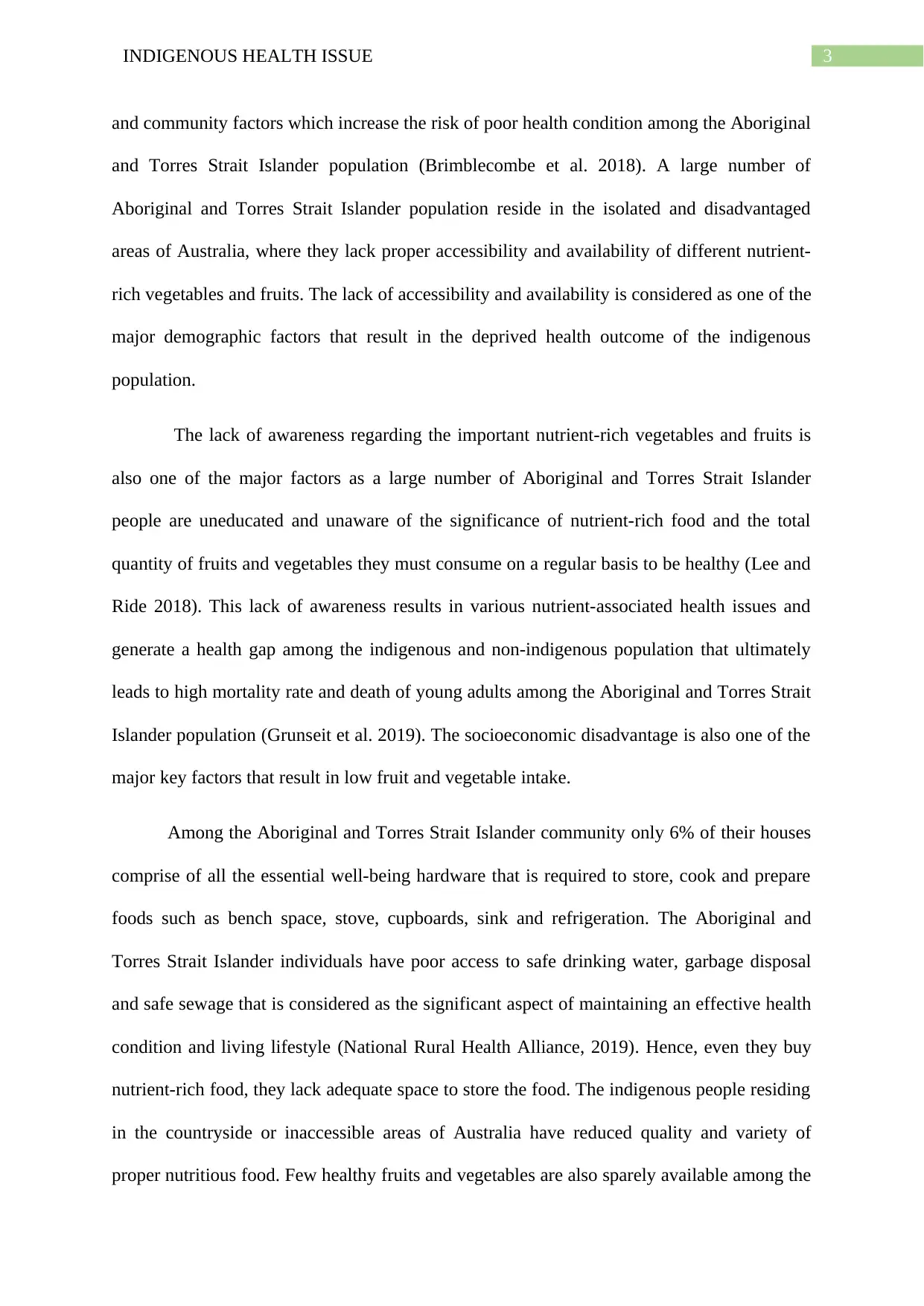
3INDIGENOUS HEALTH ISSUE
and community factors which increase the risk of poor health condition among the Aboriginal
and Torres Strait Islander population (Brimblecombe et al. 2018). A large number of
Aboriginal and Torres Strait Islander population reside in the isolated and disadvantaged
areas of Australia, where they lack proper accessibility and availability of different nutrient-
rich vegetables and fruits. The lack of accessibility and availability is considered as one of the
major demographic factors that result in the deprived health outcome of the indigenous
population.
The lack of awareness regarding the important nutrient-rich vegetables and fruits is
also one of the major factors as a large number of Aboriginal and Torres Strait Islander
people are uneducated and unaware of the significance of nutrient-rich food and the total
quantity of fruits and vegetables they must consume on a regular basis to be healthy (Lee and
Ride 2018). This lack of awareness results in various nutrient-associated health issues and
generate a health gap among the indigenous and non-indigenous population that ultimately
leads to high mortality rate and death of young adults among the Aboriginal and Torres Strait
Islander population (Grunseit et al. 2019). The socioeconomic disadvantage is also one of the
major key factors that result in low fruit and vegetable intake.
Among the Aboriginal and Torres Strait Islander community only 6% of their houses
comprise of all the essential well-being hardware that is required to store, cook and prepare
foods such as bench space, stove, cupboards, sink and refrigeration. The Aboriginal and
Torres Strait Islander individuals have poor access to safe drinking water, garbage disposal
and safe sewage that is considered as the significant aspect of maintaining an effective health
condition and living lifestyle (National Rural Health Alliance, 2019). Hence, even they buy
nutrient-rich food, they lack adequate space to store the food. The indigenous people residing
in the countryside or inaccessible areas of Australia have reduced quality and variety of
proper nutritious food. Few healthy fruits and vegetables are also sparely available among the
and community factors which increase the risk of poor health condition among the Aboriginal
and Torres Strait Islander population (Brimblecombe et al. 2018). A large number of
Aboriginal and Torres Strait Islander population reside in the isolated and disadvantaged
areas of Australia, where they lack proper accessibility and availability of different nutrient-
rich vegetables and fruits. The lack of accessibility and availability is considered as one of the
major demographic factors that result in the deprived health outcome of the indigenous
population.
The lack of awareness regarding the important nutrient-rich vegetables and fruits is
also one of the major factors as a large number of Aboriginal and Torres Strait Islander
people are uneducated and unaware of the significance of nutrient-rich food and the total
quantity of fruits and vegetables they must consume on a regular basis to be healthy (Lee and
Ride 2018). This lack of awareness results in various nutrient-associated health issues and
generate a health gap among the indigenous and non-indigenous population that ultimately
leads to high mortality rate and death of young adults among the Aboriginal and Torres Strait
Islander population (Grunseit et al. 2019). The socioeconomic disadvantage is also one of the
major key factors that result in low fruit and vegetable intake.
Among the Aboriginal and Torres Strait Islander community only 6% of their houses
comprise of all the essential well-being hardware that is required to store, cook and prepare
foods such as bench space, stove, cupboards, sink and refrigeration. The Aboriginal and
Torres Strait Islander individuals have poor access to safe drinking water, garbage disposal
and safe sewage that is considered as the significant aspect of maintaining an effective health
condition and living lifestyle (National Rural Health Alliance, 2019). Hence, even they buy
nutrient-rich food, they lack adequate space to store the food. The indigenous people residing
in the countryside or inaccessible areas of Australia have reduced quality and variety of
proper nutritious food. Few healthy fruits and vegetables are also sparely available among the
Paraphrase This Document
Need a fresh take? Get an instant paraphrase of this document with our AI Paraphraser
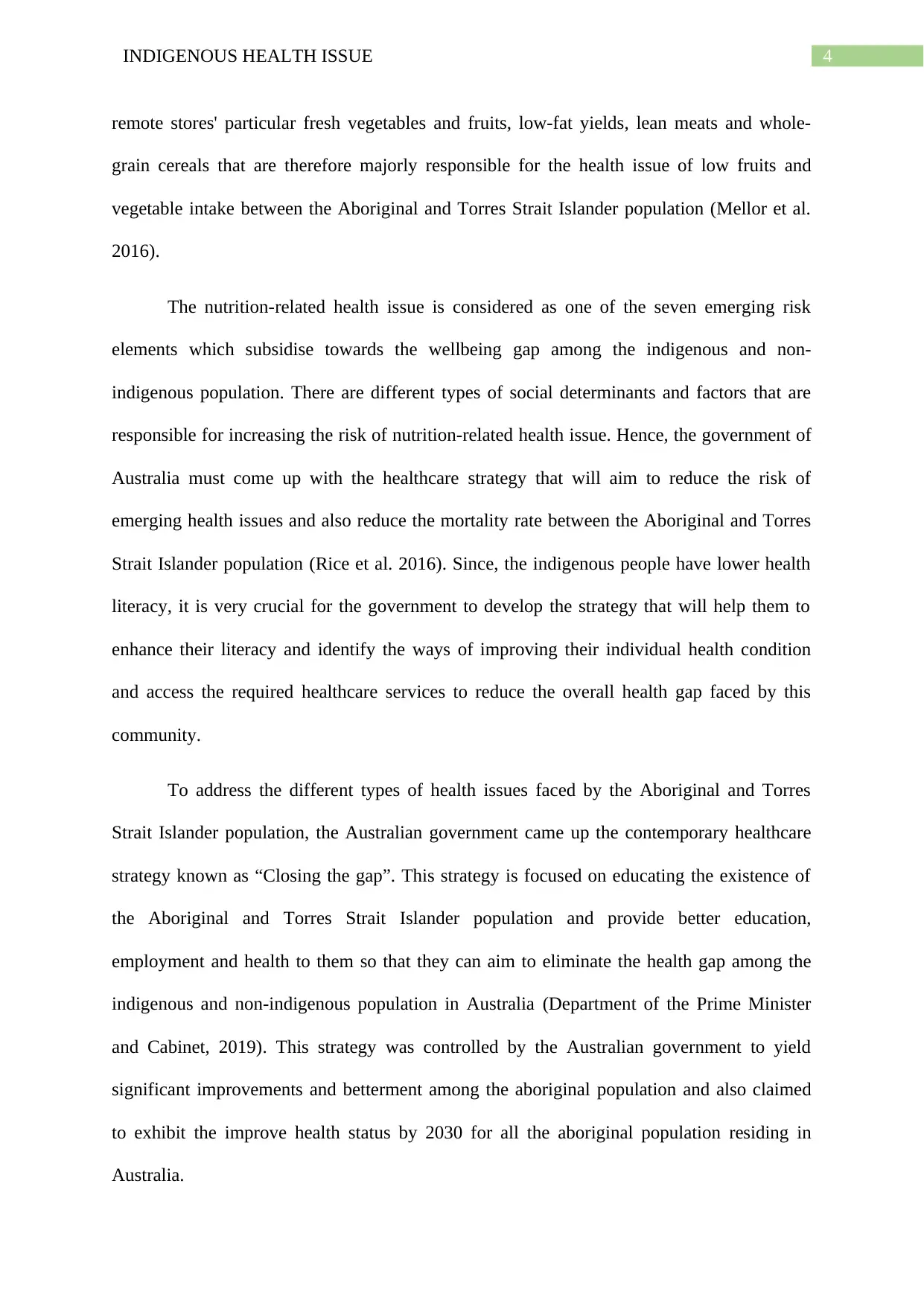
4INDIGENOUS HEALTH ISSUE
remote stores' particular fresh vegetables and fruits, low-fat yields, lean meats and whole-
grain cereals that are therefore majorly responsible for the health issue of low fruits and
vegetable intake between the Aboriginal and Torres Strait Islander population (Mellor et al.
2016).
The nutrition-related health issue is considered as one of the seven emerging risk
elements which subsidise towards the wellbeing gap among the indigenous and non-
indigenous population. There are different types of social determinants and factors that are
responsible for increasing the risk of nutrition-related health issue. Hence, the government of
Australia must come up with the healthcare strategy that will aim to reduce the risk of
emerging health issues and also reduce the mortality rate between the Aboriginal and Torres
Strait Islander population (Rice et al. 2016). Since, the indigenous people have lower health
literacy, it is very crucial for the government to develop the strategy that will help them to
enhance their literacy and identify the ways of improving their individual health condition
and access the required healthcare services to reduce the overall health gap faced by this
community.
To address the different types of health issues faced by the Aboriginal and Torres
Strait Islander population, the Australian government came up the contemporary healthcare
strategy known as “Closing the gap”. This strategy is focused on educating the existence of
the Aboriginal and Torres Strait Islander population and provide better education,
employment and health to them so that they can aim to eliminate the health gap among the
indigenous and non-indigenous population in Australia (Department of the Prime Minister
and Cabinet, 2019). This strategy was controlled by the Australian government to yield
significant improvements and betterment among the aboriginal population and also claimed
to exhibit the improve health status by 2030 for all the aboriginal population residing in
Australia.
remote stores' particular fresh vegetables and fruits, low-fat yields, lean meats and whole-
grain cereals that are therefore majorly responsible for the health issue of low fruits and
vegetable intake between the Aboriginal and Torres Strait Islander population (Mellor et al.
2016).
The nutrition-related health issue is considered as one of the seven emerging risk
elements which subsidise towards the wellbeing gap among the indigenous and non-
indigenous population. There are different types of social determinants and factors that are
responsible for increasing the risk of nutrition-related health issue. Hence, the government of
Australia must come up with the healthcare strategy that will aim to reduce the risk of
emerging health issues and also reduce the mortality rate between the Aboriginal and Torres
Strait Islander population (Rice et al. 2016). Since, the indigenous people have lower health
literacy, it is very crucial for the government to develop the strategy that will help them to
enhance their literacy and identify the ways of improving their individual health condition
and access the required healthcare services to reduce the overall health gap faced by this
community.
To address the different types of health issues faced by the Aboriginal and Torres
Strait Islander population, the Australian government came up the contemporary healthcare
strategy known as “Closing the gap”. This strategy is focused on educating the existence of
the Aboriginal and Torres Strait Islander population and provide better education,
employment and health to them so that they can aim to eliminate the health gap among the
indigenous and non-indigenous population in Australia (Department of the Prime Minister
and Cabinet, 2019). This strategy was controlled by the Australian government to yield
significant improvements and betterment among the aboriginal population and also claimed
to exhibit the improve health status by 2030 for all the aboriginal population residing in
Australia.
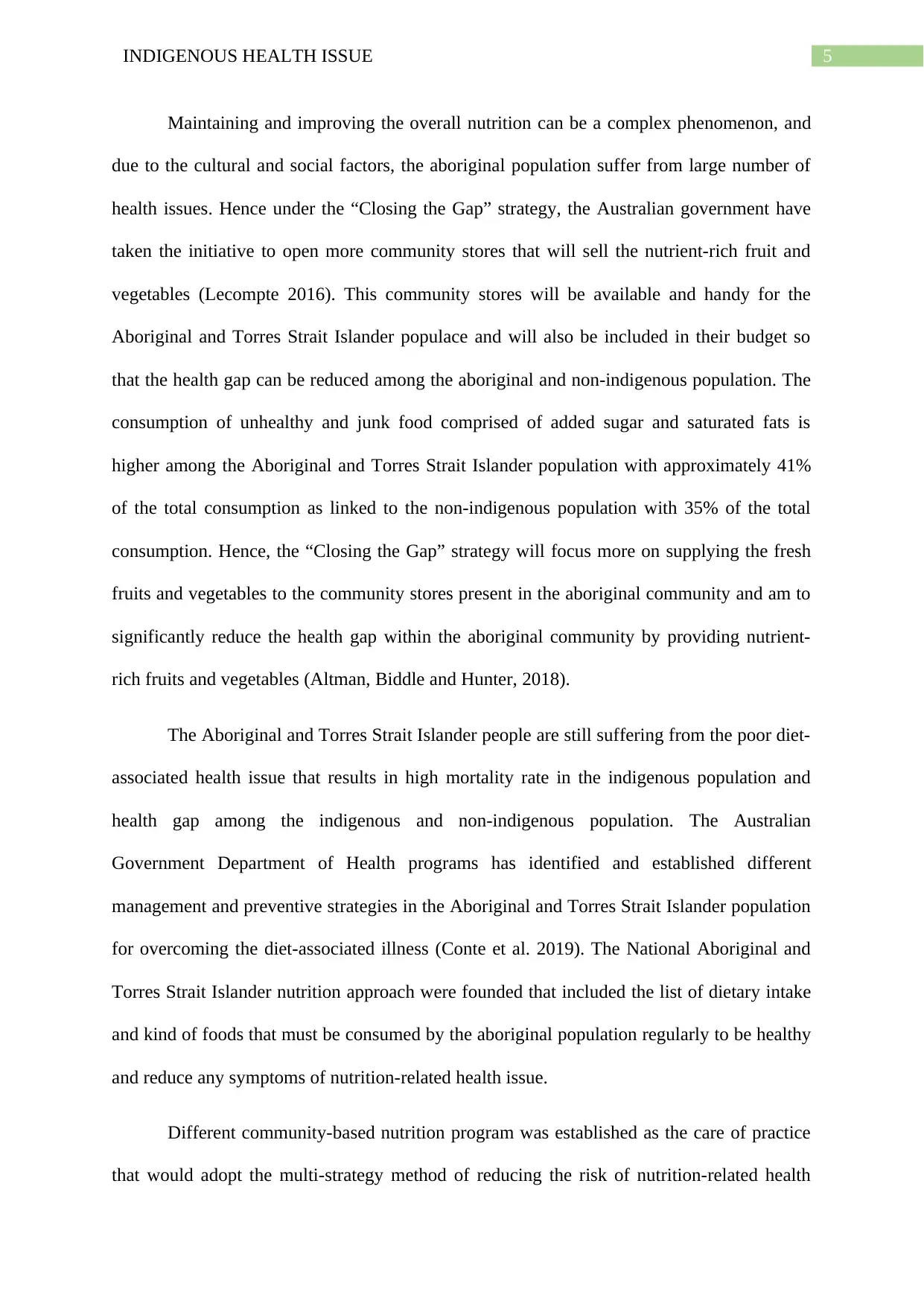
5INDIGENOUS HEALTH ISSUE
Maintaining and improving the overall nutrition can be a complex phenomenon, and
due to the cultural and social factors, the aboriginal population suffer from large number of
health issues. Hence under the “Closing the Gap” strategy, the Australian government have
taken the initiative to open more community stores that will sell the nutrient-rich fruit and
vegetables (Lecompte 2016). This community stores will be available and handy for the
Aboriginal and Torres Strait Islander populace and will also be included in their budget so
that the health gap can be reduced among the aboriginal and non-indigenous population. The
consumption of unhealthy and junk food comprised of added sugar and saturated fats is
higher among the Aboriginal and Torres Strait Islander population with approximately 41%
of the total consumption as linked to the non-indigenous population with 35% of the total
consumption. Hence, the “Closing the Gap” strategy will focus more on supplying the fresh
fruits and vegetables to the community stores present in the aboriginal community and am to
significantly reduce the health gap within the aboriginal community by providing nutrient-
rich fruits and vegetables (Altman, Biddle and Hunter, 2018).
The Aboriginal and Torres Strait Islander people are still suffering from the poor diet-
associated health issue that results in high mortality rate in the indigenous population and
health gap among the indigenous and non-indigenous population. The Australian
Government Department of Health programs has identified and established different
management and preventive strategies in the Aboriginal and Torres Strait Islander population
for overcoming the diet-associated illness (Conte et al. 2019). The National Aboriginal and
Torres Strait Islander nutrition approach were founded that included the list of dietary intake
and kind of foods that must be consumed by the aboriginal population regularly to be healthy
and reduce any symptoms of nutrition-related health issue.
Different community-based nutrition program was established as the care of practice
that would adopt the multi-strategy method of reducing the risk of nutrition-related health
Maintaining and improving the overall nutrition can be a complex phenomenon, and
due to the cultural and social factors, the aboriginal population suffer from large number of
health issues. Hence under the “Closing the Gap” strategy, the Australian government have
taken the initiative to open more community stores that will sell the nutrient-rich fruit and
vegetables (Lecompte 2016). This community stores will be available and handy for the
Aboriginal and Torres Strait Islander populace and will also be included in their budget so
that the health gap can be reduced among the aboriginal and non-indigenous population. The
consumption of unhealthy and junk food comprised of added sugar and saturated fats is
higher among the Aboriginal and Torres Strait Islander population with approximately 41%
of the total consumption as linked to the non-indigenous population with 35% of the total
consumption. Hence, the “Closing the Gap” strategy will focus more on supplying the fresh
fruits and vegetables to the community stores present in the aboriginal community and am to
significantly reduce the health gap within the aboriginal community by providing nutrient-
rich fruits and vegetables (Altman, Biddle and Hunter, 2018).
The Aboriginal and Torres Strait Islander people are still suffering from the poor diet-
associated health issue that results in high mortality rate in the indigenous population and
health gap among the indigenous and non-indigenous population. The Australian
Government Department of Health programs has identified and established different
management and preventive strategies in the Aboriginal and Torres Strait Islander population
for overcoming the diet-associated illness (Conte et al. 2019). The National Aboriginal and
Torres Strait Islander nutrition approach were founded that included the list of dietary intake
and kind of foods that must be consumed by the aboriginal population regularly to be healthy
and reduce any symptoms of nutrition-related health issue.
Different community-based nutrition program was established as the care of practice
that would adopt the multi-strategy method of reducing the risk of nutrition-related health
⊘ This is a preview!⊘
Do you want full access?
Subscribe today to unlock all pages.

Trusted by 1+ million students worldwide
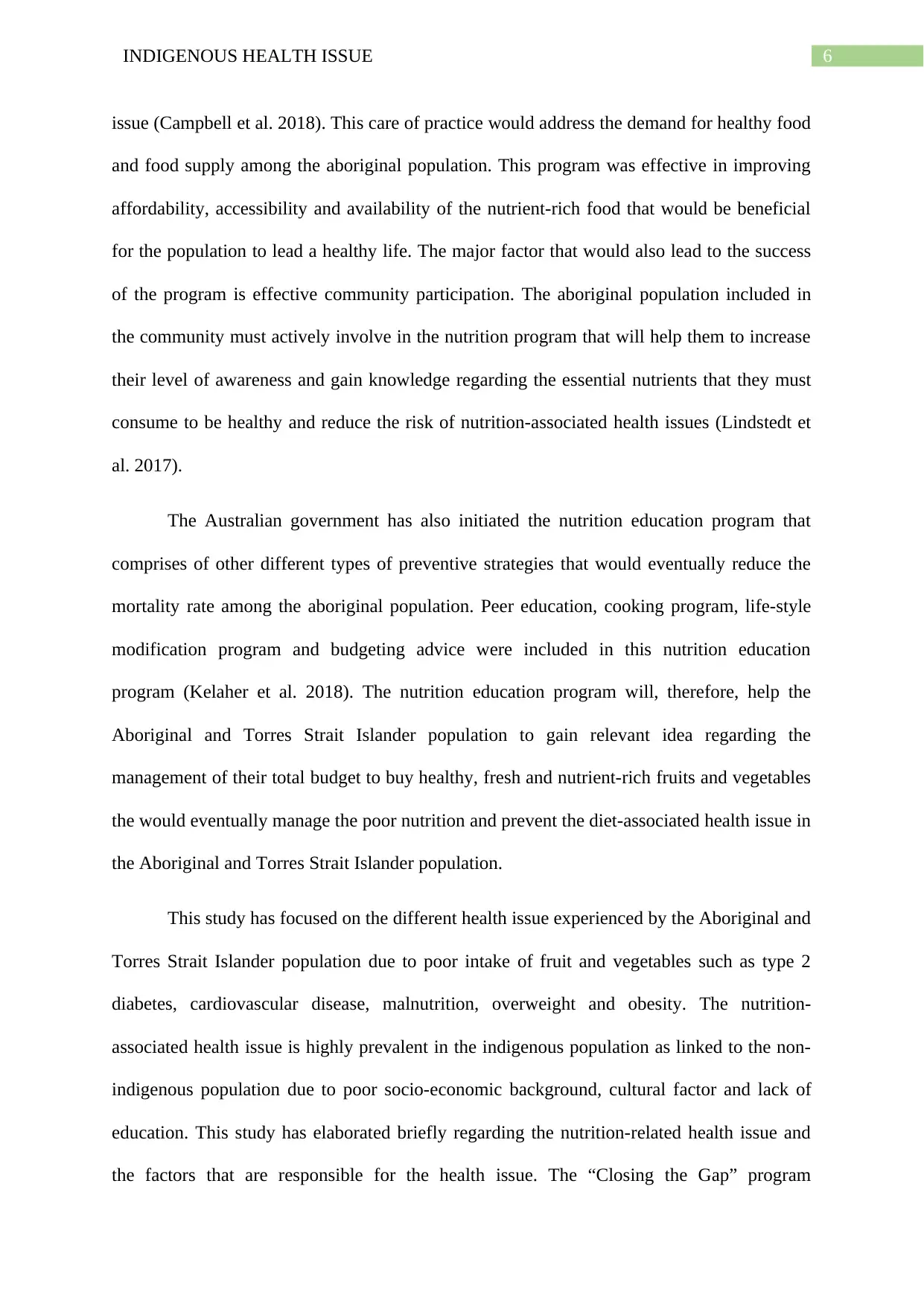
6INDIGENOUS HEALTH ISSUE
issue (Campbell et al. 2018). This care of practice would address the demand for healthy food
and food supply among the aboriginal population. This program was effective in improving
affordability, accessibility and availability of the nutrient-rich food that would be beneficial
for the population to lead a healthy life. The major factor that would also lead to the success
of the program is effective community participation. The aboriginal population included in
the community must actively involve in the nutrition program that will help them to increase
their level of awareness and gain knowledge regarding the essential nutrients that they must
consume to be healthy and reduce the risk of nutrition-associated health issues (Lindstedt et
al. 2017).
The Australian government has also initiated the nutrition education program that
comprises of other different types of preventive strategies that would eventually reduce the
mortality rate among the aboriginal population. Peer education, cooking program, life-style
modification program and budgeting advice were included in this nutrition education
program (Kelaher et al. 2018). The nutrition education program will, therefore, help the
Aboriginal and Torres Strait Islander population to gain relevant idea regarding the
management of their total budget to buy healthy, fresh and nutrient-rich fruits and vegetables
the would eventually manage the poor nutrition and prevent the diet-associated health issue in
the Aboriginal and Torres Strait Islander population.
This study has focused on the different health issue experienced by the Aboriginal and
Torres Strait Islander population due to poor intake of fruit and vegetables such as type 2
diabetes, cardiovascular disease, malnutrition, overweight and obesity. The nutrition-
associated health issue is highly prevalent in the indigenous population as linked to the non-
indigenous population due to poor socio-economic background, cultural factor and lack of
education. This study has elaborated briefly regarding the nutrition-related health issue and
the factors that are responsible for the health issue. The “Closing the Gap” program
issue (Campbell et al. 2018). This care of practice would address the demand for healthy food
and food supply among the aboriginal population. This program was effective in improving
affordability, accessibility and availability of the nutrient-rich food that would be beneficial
for the population to lead a healthy life. The major factor that would also lead to the success
of the program is effective community participation. The aboriginal population included in
the community must actively involve in the nutrition program that will help them to increase
their level of awareness and gain knowledge regarding the essential nutrients that they must
consume to be healthy and reduce the risk of nutrition-associated health issues (Lindstedt et
al. 2017).
The Australian government has also initiated the nutrition education program that
comprises of other different types of preventive strategies that would eventually reduce the
mortality rate among the aboriginal population. Peer education, cooking program, life-style
modification program and budgeting advice were included in this nutrition education
program (Kelaher et al. 2018). The nutrition education program will, therefore, help the
Aboriginal and Torres Strait Islander population to gain relevant idea regarding the
management of their total budget to buy healthy, fresh and nutrient-rich fruits and vegetables
the would eventually manage the poor nutrition and prevent the diet-associated health issue in
the Aboriginal and Torres Strait Islander population.
This study has focused on the different health issue experienced by the Aboriginal and
Torres Strait Islander population due to poor intake of fruit and vegetables such as type 2
diabetes, cardiovascular disease, malnutrition, overweight and obesity. The nutrition-
associated health issue is highly prevalent in the indigenous population as linked to the non-
indigenous population due to poor socio-economic background, cultural factor and lack of
education. This study has elaborated briefly regarding the nutrition-related health issue and
the factors that are responsible for the health issue. The “Closing the Gap” program
Paraphrase This Document
Need a fresh take? Get an instant paraphrase of this document with our AI Paraphraser
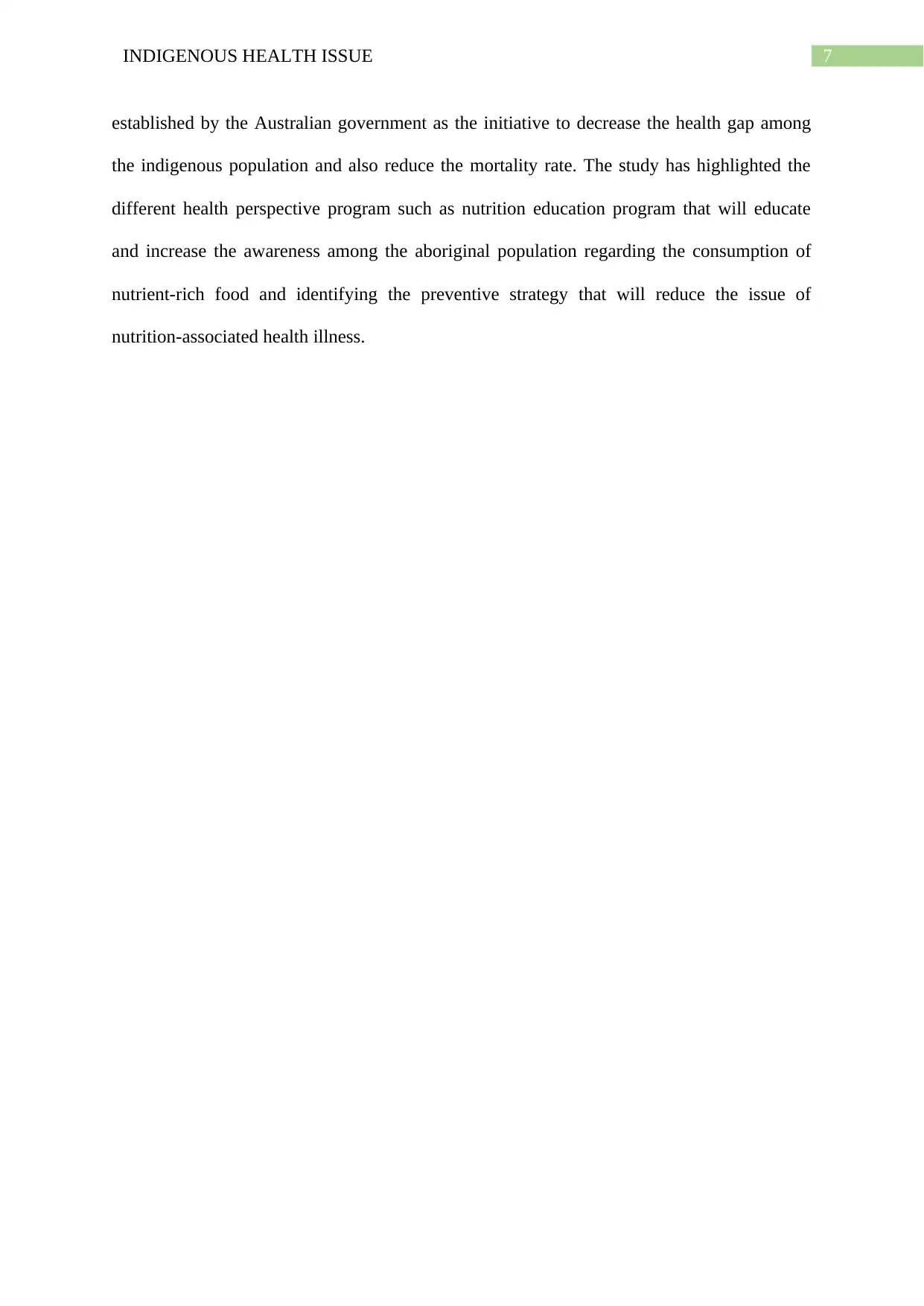
7INDIGENOUS HEALTH ISSUE
established by the Australian government as the initiative to decrease the health gap among
the indigenous population and also reduce the mortality rate. The study has highlighted the
different health perspective program such as nutrition education program that will educate
and increase the awareness among the aboriginal population regarding the consumption of
nutrient-rich food and identifying the preventive strategy that will reduce the issue of
nutrition-associated health illness.
established by the Australian government as the initiative to decrease the health gap among
the indigenous population and also reduce the mortality rate. The study has highlighted the
different health perspective program such as nutrition education program that will educate
and increase the awareness among the aboriginal population regarding the consumption of
nutrient-rich food and identifying the preventive strategy that will reduce the issue of
nutrition-associated health illness.
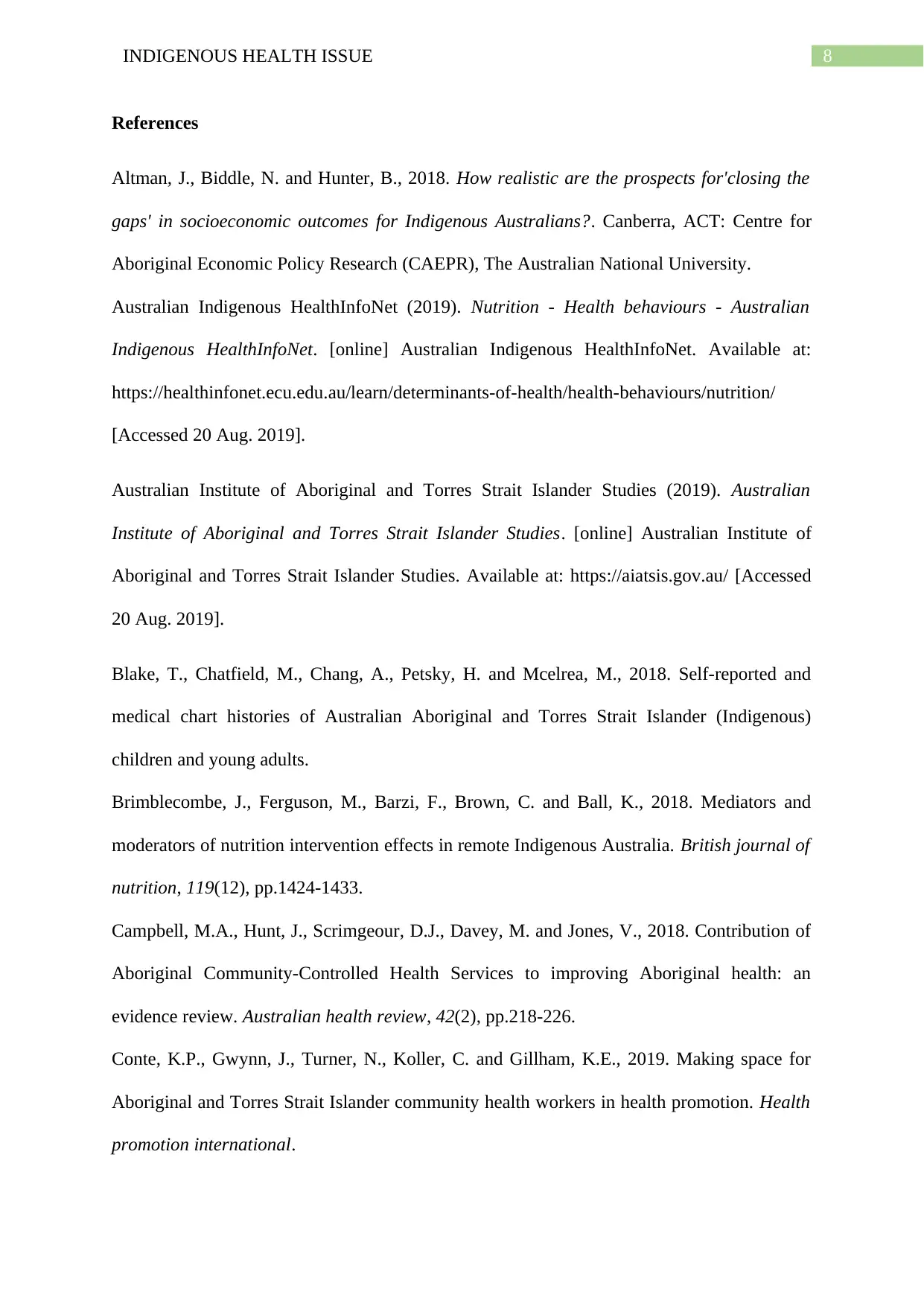
8INDIGENOUS HEALTH ISSUE
References
Altman, J., Biddle, N. and Hunter, B., 2018. How realistic are the prospects for'closing the
gaps' in socioeconomic outcomes for Indigenous Australians?. Canberra, ACT: Centre for
Aboriginal Economic Policy Research (CAEPR), The Australian National University.
Australian Indigenous HealthInfoNet (2019). Nutrition - Health behaviours - Australian
Indigenous HealthInfoNet. [online] Australian Indigenous HealthInfoNet. Available at:
https://healthinfonet.ecu.edu.au/learn/determinants-of-health/health-behaviours/nutrition/
[Accessed 20 Aug. 2019].
Australian Institute of Aboriginal and Torres Strait Islander Studies (2019). Australian
Institute of Aboriginal and Torres Strait Islander Studies. [online] Australian Institute of
Aboriginal and Torres Strait Islander Studies. Available at: https://aiatsis.gov.au/ [Accessed
20 Aug. 2019].
Blake, T., Chatfield, M., Chang, A., Petsky, H. and Mcelrea, M., 2018. Self-reported and
medical chart histories of Australian Aboriginal and Torres Strait Islander (Indigenous)
children and young adults.
Brimblecombe, J., Ferguson, M., Barzi, F., Brown, C. and Ball, K., 2018. Mediators and
moderators of nutrition intervention effects in remote Indigenous Australia. British journal of
nutrition, 119(12), pp.1424-1433.
Campbell, M.A., Hunt, J., Scrimgeour, D.J., Davey, M. and Jones, V., 2018. Contribution of
Aboriginal Community-Controlled Health Services to improving Aboriginal health: an
evidence review. Australian health review, 42(2), pp.218-226.
Conte, K.P., Gwynn, J., Turner, N., Koller, C. and Gillham, K.E., 2019. Making space for
Aboriginal and Torres Strait Islander community health workers in health promotion. Health
promotion international.
References
Altman, J., Biddle, N. and Hunter, B., 2018. How realistic are the prospects for'closing the
gaps' in socioeconomic outcomes for Indigenous Australians?. Canberra, ACT: Centre for
Aboriginal Economic Policy Research (CAEPR), The Australian National University.
Australian Indigenous HealthInfoNet (2019). Nutrition - Health behaviours - Australian
Indigenous HealthInfoNet. [online] Australian Indigenous HealthInfoNet. Available at:
https://healthinfonet.ecu.edu.au/learn/determinants-of-health/health-behaviours/nutrition/
[Accessed 20 Aug. 2019].
Australian Institute of Aboriginal and Torres Strait Islander Studies (2019). Australian
Institute of Aboriginal and Torres Strait Islander Studies. [online] Australian Institute of
Aboriginal and Torres Strait Islander Studies. Available at: https://aiatsis.gov.au/ [Accessed
20 Aug. 2019].
Blake, T., Chatfield, M., Chang, A., Petsky, H. and Mcelrea, M., 2018. Self-reported and
medical chart histories of Australian Aboriginal and Torres Strait Islander (Indigenous)
children and young adults.
Brimblecombe, J., Ferguson, M., Barzi, F., Brown, C. and Ball, K., 2018. Mediators and
moderators of nutrition intervention effects in remote Indigenous Australia. British journal of
nutrition, 119(12), pp.1424-1433.
Campbell, M.A., Hunt, J., Scrimgeour, D.J., Davey, M. and Jones, V., 2018. Contribution of
Aboriginal Community-Controlled Health Services to improving Aboriginal health: an
evidence review. Australian health review, 42(2), pp.218-226.
Conte, K.P., Gwynn, J., Turner, N., Koller, C. and Gillham, K.E., 2019. Making space for
Aboriginal and Torres Strait Islander community health workers in health promotion. Health
promotion international.
⊘ This is a preview!⊘
Do you want full access?
Subscribe today to unlock all pages.

Trusted by 1+ million students worldwide

9INDIGENOUS HEALTH ISSUE
Department of the Prime Minister and Cabinet (2019). Closing The Gap |. [online]
Closingthegap.pmc.gov.au. Available at: https://closingthegap.pmc.gov.au/ [Accessed 20
Aug. 2019].
Grunseit, A.C., Bohn‐Goldbaum, E., Crane, M., Milat, A., Cashmore, A., Fonua, R., Gow,
A., Havrlant, R., Reid, K., Hennessey, K. and Firth, W., 2019. Participant profile and impacts
of an Aboriginal healthy lifestyle and weight loss challenge over four years 2012–2015.
Australian and New Zealand journal of public health.
Kelaher, M., Luke, J., Ferdinand, A., Chamravi, D., Ewen, S. and Paradies, Y., 2018.
Evaluation Framework to Improve Aboriginal and Torres Strait Islander Health, An.
Evaluation Framework to Improve Aboriginal and Torres Strait Islander Health, An, p.x.
Lecompte, E.M., 2016. A Mixed Methods Study of the Factors that Enhance and Challenge
Food Security, Fruit and Vegetable Access and Consumption, and the Uptake and
Management of the Ottawa Good Food Box (Doctoral dissertation, Université
d'Ottawa/University of Ottawa).
Lee, A. and Ride, K., 2018. Review of nutrition among Aboriginal and Torres Strait Islander
people. Australian Indigenous HealthInfoNet.
Lindstedt, S., Moeller-Saxone, K., Black, C., Herrman, H. and Szwarc, J., 2017. Realist
review of programs, policies, and interventions to enhance the social, emotional, and spiritual
well-being of Aboriginal and Torres Strait Islander young people living in out-of-home care.
The International Indigenous Policy Journal, 8(3), p.5.
Lukaszyk, C., Radford, K., Delbaere, K., Ivers, R., Rogers, K., Sherrington, C., Tiedemann,
A., Coombes, J., Daylight, G., Draper, B. and Broe, T., 2018. Risk factors for falls among
older Aboriginal and Torres Strait Islander people in urban and regional communities.
Australasian journal on ageing, 37(2), pp.113-119.
Department of the Prime Minister and Cabinet (2019). Closing The Gap |. [online]
Closingthegap.pmc.gov.au. Available at: https://closingthegap.pmc.gov.au/ [Accessed 20
Aug. 2019].
Grunseit, A.C., Bohn‐Goldbaum, E., Crane, M., Milat, A., Cashmore, A., Fonua, R., Gow,
A., Havrlant, R., Reid, K., Hennessey, K. and Firth, W., 2019. Participant profile and impacts
of an Aboriginal healthy lifestyle and weight loss challenge over four years 2012–2015.
Australian and New Zealand journal of public health.
Kelaher, M., Luke, J., Ferdinand, A., Chamravi, D., Ewen, S. and Paradies, Y., 2018.
Evaluation Framework to Improve Aboriginal and Torres Strait Islander Health, An.
Evaluation Framework to Improve Aboriginal and Torres Strait Islander Health, An, p.x.
Lecompte, E.M., 2016. A Mixed Methods Study of the Factors that Enhance and Challenge
Food Security, Fruit and Vegetable Access and Consumption, and the Uptake and
Management of the Ottawa Good Food Box (Doctoral dissertation, Université
d'Ottawa/University of Ottawa).
Lee, A. and Ride, K., 2018. Review of nutrition among Aboriginal and Torres Strait Islander
people. Australian Indigenous HealthInfoNet.
Lindstedt, S., Moeller-Saxone, K., Black, C., Herrman, H. and Szwarc, J., 2017. Realist
review of programs, policies, and interventions to enhance the social, emotional, and spiritual
well-being of Aboriginal and Torres Strait Islander young people living in out-of-home care.
The International Indigenous Policy Journal, 8(3), p.5.
Lukaszyk, C., Radford, K., Delbaere, K., Ivers, R., Rogers, K., Sherrington, C., Tiedemann,
A., Coombes, J., Daylight, G., Draper, B. and Broe, T., 2018. Risk factors for falls among
older Aboriginal and Torres Strait Islander people in urban and regional communities.
Australasian journal on ageing, 37(2), pp.113-119.
Paraphrase This Document
Need a fresh take? Get an instant paraphrase of this document with our AI Paraphraser
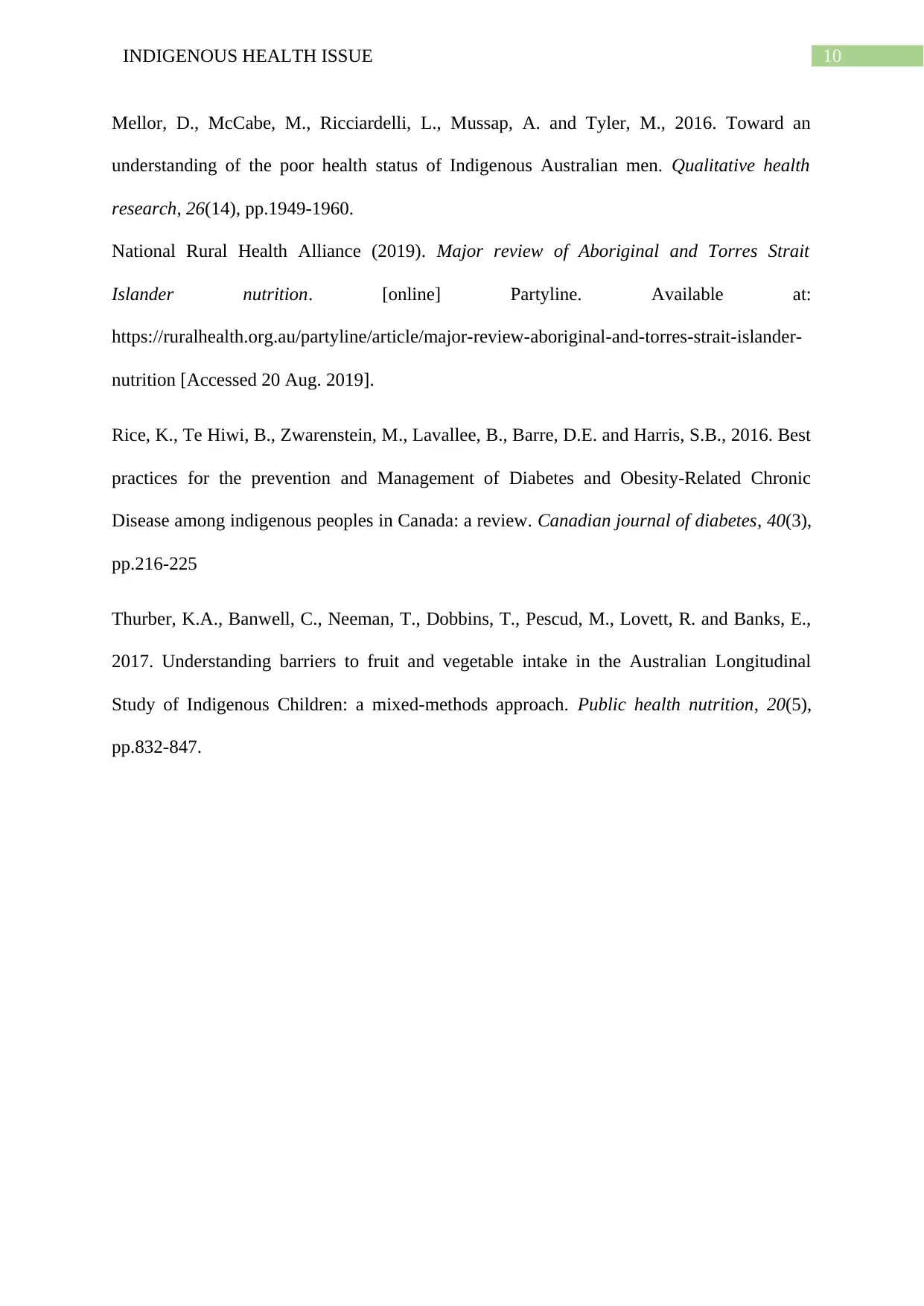
10INDIGENOUS HEALTH ISSUE
Mellor, D., McCabe, M., Ricciardelli, L., Mussap, A. and Tyler, M., 2016. Toward an
understanding of the poor health status of Indigenous Australian men. Qualitative health
research, 26(14), pp.1949-1960.
National Rural Health Alliance (2019). Major review of Aboriginal and Torres Strait
Islander nutrition. [online] Partyline. Available at:
https://ruralhealth.org.au/partyline/article/major-review-aboriginal-and-torres-strait-islander-
nutrition [Accessed 20 Aug. 2019].
Rice, K., Te Hiwi, B., Zwarenstein, M., Lavallee, B., Barre, D.E. and Harris, S.B., 2016. Best
practices for the prevention and Management of Diabetes and Obesity-Related Chronic
Disease among indigenous peoples in Canada: a review. Canadian journal of diabetes, 40(3),
pp.216-225
Thurber, K.A., Banwell, C., Neeman, T., Dobbins, T., Pescud, M., Lovett, R. and Banks, E.,
2017. Understanding barriers to fruit and vegetable intake in the Australian Longitudinal
Study of Indigenous Children: a mixed-methods approach. Public health nutrition, 20(5),
pp.832-847.
Mellor, D., McCabe, M., Ricciardelli, L., Mussap, A. and Tyler, M., 2016. Toward an
understanding of the poor health status of Indigenous Australian men. Qualitative health
research, 26(14), pp.1949-1960.
National Rural Health Alliance (2019). Major review of Aboriginal and Torres Strait
Islander nutrition. [online] Partyline. Available at:
https://ruralhealth.org.au/partyline/article/major-review-aboriginal-and-torres-strait-islander-
nutrition [Accessed 20 Aug. 2019].
Rice, K., Te Hiwi, B., Zwarenstein, M., Lavallee, B., Barre, D.E. and Harris, S.B., 2016. Best
practices for the prevention and Management of Diabetes and Obesity-Related Chronic
Disease among indigenous peoples in Canada: a review. Canadian journal of diabetes, 40(3),
pp.216-225
Thurber, K.A., Banwell, C., Neeman, T., Dobbins, T., Pescud, M., Lovett, R. and Banks, E.,
2017. Understanding barriers to fruit and vegetable intake in the Australian Longitudinal
Study of Indigenous Children: a mixed-methods approach. Public health nutrition, 20(5),
pp.832-847.
1 out of 11
Related Documents
Your All-in-One AI-Powered Toolkit for Academic Success.
+13062052269
info@desklib.com
Available 24*7 on WhatsApp / Email
![[object Object]](/_next/static/media/star-bottom.7253800d.svg)
Unlock your academic potential
Copyright © 2020–2025 A2Z Services. All Rights Reserved. Developed and managed by ZUCOL.





